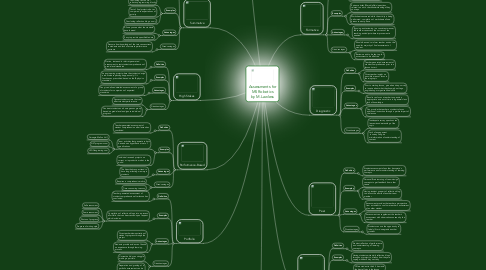
1. Sources
1.1. Kushwaha, Santosh, and Katie Lepi. "The 6 Types Of Assessments (And How They’re Changing)." The 6 Types Of Assessments (And How They're Changing). Edudemic, 22 July 2013. Web. 9 Nov. 2014. <http://www.edudemic.com/the-6-types-of-assessments-and-how-theyre-changing/>.
1.2. Ebert II, Edward, Christine Ebert, and Michael Bentley. "Types of Classroom Assessment." Education.com. 18 Nov. 2011. Web. 9 Nov. 2014. <http://www.education.com/reference/article/types-classroom-assessment/>.
1.3. "Portfolio Assessment." Portfolio Assessment. EduPlace, 1 Jan. 1997. Web. 9 Nov. 2014. <http://www.eduplace.com/rdg/res/literacy/assess6.html>.
1.4. Fersten, Linda. "Portfolio Assessment." Education.com. 23 Dec. 2009. Web. 9 Nov. 2014. <http://www.education.com/reference/article/portfolio-assessment/>.
1.5. "Authentic Assessment." TeacherVision.com. Web. 9 Nov. 2014. <https://www.teachervision.com/assessment/resource/5946.html?detoured=1
2. Portfolio
2.1. Definition
2.1.1. Teacher generated assessment of student comprehension after lesson has concluded
2.2. Examples
2.2.1. Compilation of reflection blogs into a process ePortfolio that can be accessed upon request which includes
2.2.1.1. Self-assessment
2.2.1.2. Peer-assessment
2.2.1.3. Photos of progress
2.2.1.4. Progress of writing style
2.3. Advantages
2.3.1. Gives teacher demonstration of student's progress through the project
2.3.2. Students provide evidence of hands on experience through learning process
2.4. Disadvantages
2.4.1. Uncreative kids can struggle making a portfolo
2.4.2. Preparation and grading of a portfolio assessment can be time-consuming
3. High Stakes
3.1. Definition
3.1.1. Nation, state and/or district generated assessment to test student comprehension of grade level standards
3.2. Examples
3.2.1. An engineering project where the students design a robot where passing happens only if it functions as prescribed based on the IB physics standards
3.3. Advantages
3.3.1. Can give defined detailed assessment of a group of students for comparison of expected standards
3.4. Disadvantages
3.4.1. Causes students stress that can effect student performance
3.4.2. Can treat students as a homogenous group based on grade level and ignore individual progress
4. Performance-Based
4.1. Definition
4.1.1. Teacher generated assessment of student comprehension after lesson has concluded
4.2. Examples
4.2.1. Team activities that generate robots based on an hypothesis or set of specifications
4.2.1.1. Carnegie-Mellon Vol 1
4.2.1.2. NXTprograms.com
4.2.1.3. LEGOenginering.com
4.2.2. Individual research project on a current or in production robot in the world
4.3. Advantages
4.3.1. The kinesthetic aspect tend to have longer lasting memory in students
4.4. Disadvantages
4.4.1. Requires a comprehensive rubric
4.4.2. Time-consuming to assss
5. Summative
5.1. Definition
5.1.1. Teacher generated assessment of student comprehension after lesson has concluded
5.1.2. Provides a final grade to assign student for lesson studied
5.2. Examples
5.2.1. Concluding test on NXT robotics programming blocks
5.2.2. Test of final project robot as compared to expectations of activity
5.2.3. Concluding reflection blog on unit
5.3. Advantages
5.3.1. Allows you see what the students have learned
5.3.2. Easy to provide quantifiable data
5.4. Disadvantages
5.4.1. Pressure from knowledge of the test causes stress in students and lack of accurate performance outcome
6. Authentic
6.1. Definition
6.1.1. Assessment where student demonstrates real world application of lesson
6.2. Examples
6.2.1. Determine a a real world application for a robot creation from the past robots created
6.2.2. Team activity where the students create a robot that performs a common real function
6.3. Advantages
6.3.1. Shows student can demonstrate 21st century skills to succeed in real world
6.4. Disadvantages
6.4.1. Can be hard to equate to standards that are typically tested
7. Peer
7.1. Definition
7.1.1. Student assessment of another classmate's performance and/or understanding of learning concepts
7.2. Examples
7.2.1. Carousel Brainstorming of team design concepts to get feedback from other teams
7.2.2. Having student use part of reflection blog to discuss the efforts of another team member
7.3. Advantages
7.3.1. Assessment provides the teacher a perspective from a student to confirm a teacher's assessment of another student
7.3.2. Assessment can supplement the teacher's assessment with observations unseen by the teacher
7.4. Disadvantages
7.4.1. Students can use the opportunity to falsely lift or downgrade another student
8. Self
8.1. Definition
8.1.1. Student reflection of performance and understanding of learning concepts
8.2. Examples
8.2.1. Having students write daily reflection blogs throughout project to discuss how they are coping with each day's activity
8.3. Advantages
8.3.1. Offers student to think if he made the best efforts in the lesson
8.3.2. Empowers the students to provide the teacher personal fedback on the lesson taught in rlation to his gras of understanding the lesson
8.4. Disadvantages
8.4.1. Students can falsely lift or downgrade themselves
8.4.2. Students can lack insight to properly examine themselves
9. Formative
9.1. Definition
9.1.1. Teacher generated assessment of student periodically occurring throughout lesson/unit
9.1.2. Outcomes usually inform teacher how to adjust teaching strategies
9.2. Examples
9.2.1. Entrance ticket (WarmUpQuiz) questions related to unit to check understanding of key conceps
9.2.2. Worksheets answered while the activity is being performed; completion of worksheets allows access to next phase
9.3. Advantages
9.3.1. By using and reviewing in a consistent manner, the teacher can assess the success of the teaching and adjust where improvement is needed
9.4. Disadvantages
9.4.1. Should be used to inform teacher and not be used for majority of final assessment of student
9.4.2. Review needs to be kept up for assessment to be effective
10. Diagnostic
10.1. Definition
10.1.1. Teacher generated assessment of student comprehension prior to a lesson's start
10.1.2. Gives teacher insight on possible areas of focus in learning topic
10.2. Examples
10.2.1. Prior to starting lesson, give a heads-up survey to inquire about what they know about Lego, engineering or organizational skills
10.3. Advantages
10.3.1. Results can focus a teacher to spend an appropriate amount of time in a general class' lack of knowledge
10.3.2. Can provide the teacher a student to focus additional instruction through a particular part of the lesson
10.4. Disadvantages
10.4.1. Inadequate survey questions can leave misunderstanding of the topic
10.4.2. Lack of engagement in survey can give misinformation of understanding of content
